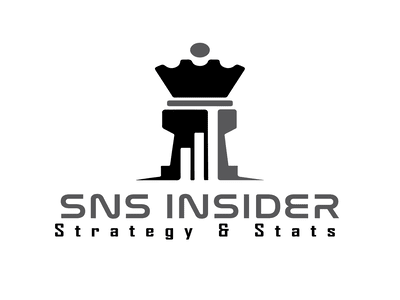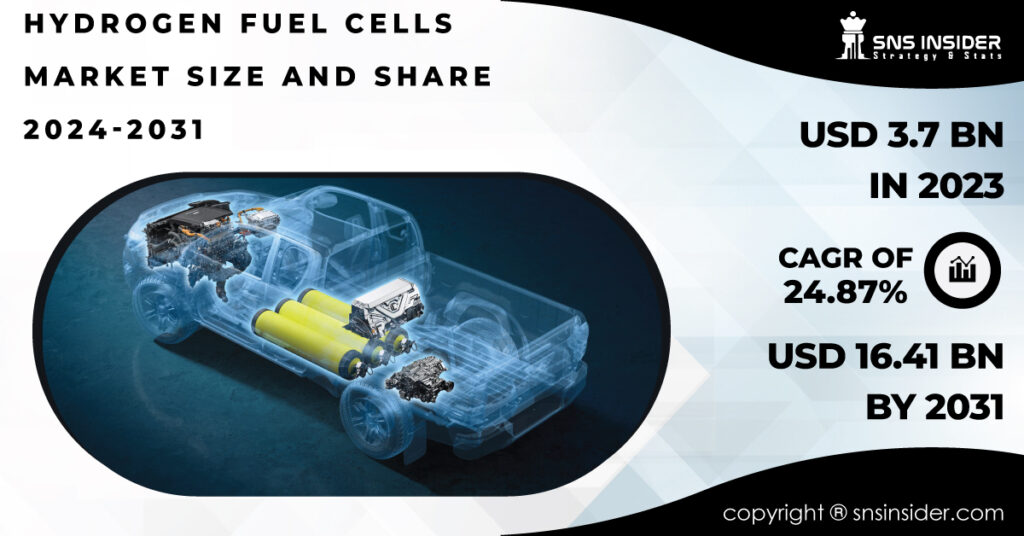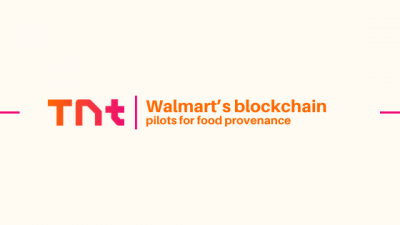
According to SNS Insider, the Hydrogen Fuel Cell Market valuation to reach USD 16.41 billion by 2031. The estimated CAGR projected for the forecast period of 2024-2031 is 24.87%.
The hydrogen fuel cell market is rapidly gaining traction as a viable solution for a decarbonized future. These electrochemical devices convert hydrogen gas and oxygen into electricity, producing only water vapor as a byproduct. This clean energy technology holds immense potential across various sectors, including transportation, stationary power generation, and portable applications.
Get a Free Sample Report of Hydrogen Fuel Cell Market @ https://www.snsinsider.com/sample-request/2719

The Hydrogen Fuel Cell Market: A Promising Path Towards Clean Energy
Major Key Players Included are:
- FuelCell Energy Inc.
- Ballard Power Systems
- Hydrogenics Corporation
- SFC Energy AG
- Nedstack Fuel Cell Technology B.V.
- Bloom Energy
- Doosan Fuel Cell America, Inc.
- Ceres Power Holdings PLC
- Plug Power, Inc.
- Nuvera Fuel Cells LLC
What are the growth factors?
Stringent environmental regulations: Governments worldwide are implementing stricter emission norms to combat climate change. Hydrogen fuel cells offer a clean alternative to traditional fossil fuel-based technologies, making them increasingly attractive.
Rising concerns over energy security: The dependence on traditional energy sources like oil can be politically and economically volatile. Hydrogen fuel cells, coupled with renewable hydrogen production, offer a path towards energy independence.
Technological advancements: Advancements in materials science, membrane development, and catalyst design are leading to more efficient, durable, and cost-effective fuel cells.
Government support: Many governments are actively promoting hydrogen fuel cell technology through subsidies, tax breaks, and funding for research and development. This fosters innovation and facilitates infrastructure development.
Segment Analysis:
By technology type: Proton exchange membrane (PEM) fuel cells currently dominate the market due to their compactness, quick start-up times, and suitability for transportation applications. Other types include solid oxide, phosphoric acid, and molten carbonate fuel cells, each catering to specific use cases.
By application: The transportation sector, particularly electric vehicles (EVs) powered by hydrogen fuel cells, is expected to be the primary driver of market growth. However, stationary power generation for residential and commercial buildings, as well as portable applications for powering electronics and disaster relief efforts, are also gaining traction.
Market segmentation
By Product Type
- Liquid-Cooled Type
- Air-Cooled Type
By Technology Type
- Polymer Exchange Membrane Fuel Cells (PEMFC)
- Phosphoric Acid Fuel Cells (PAFC)
- Solid Oxide Fuel Cells (SOFC)
- Direct Methanol Fuel Cells (DMFC)
- Molten Carbonate Fuel Cells (MCFC)
- Others
By Application
- Stationary
- Transportation
- Portable
By End-user
- Fuel Cell Vehicles
- Utilities
- Defense
- Others
Enquire about the Report @ https://www.snsinsider.com/enquiry/2719
Opportunity analysis reveals promising avenues for growth:
Development of hydrogen infrastructure: Building a robust network of hydrogen refuelling stations is crucial for widespread adoption of fuel cell vehicles. Several companies, including Shell, TotalEnergies, and Hyundai, are making significant investments in this area.
Focus on cost reduction: Reducing the upfront cost of fuel cells and hydrogen production is essential for wider market acceptance. Advancements in manufacturing processes and economies of scale will play a key role.
Expansion into new applications: Fuel cells have the potential to power various applications beyond transportation, such as drones, maritime vessels, and even data centers. Exploring these possibilities will broaden the market landscape.
Regional Analysis:
Asia Pacific region currently leads the market, driven by strong government support in countries like Japan, South Korea, and China. Europe is witnessing significant growth with ambitious hydrogen strategies and investments in infrastructure development. While lagging behind Asia, North America is catching up with initiatives promoting hydrogen fuel cell technology adoption.
Recent developments:
Toyota: Launched the second generation Mirai hydrogen fuel cell car, boasting extended range and improved performance.
Hyundai: Unveiled the next-generation Nexo SUV with a longer driving range and faster refueling times.
Plug Power: Announced a collaboration with Renault to develop hydrogen fuel cell-powered vans for the commercial transportation sector.
Bloom Energy: Secured a multi-million-dollar contract to provide hydrogen fuel cell power for a data center complex.
Key takeaways:
The hydrogen fuel cell market is poised for significant growth, driven by environmental concerns, energy security considerations, and technological advancements.
Government support and ongoing research hold the promise of overcoming challenges related to cost reduction and infrastructure development. With continued innovation and strategic collaborations, hydrogen fuel cells have the potential to become a mainstream clean energy solution, shaping a sustainable future.
Buy Single User PDF of Hydrogen Fuel Cell Market Report @ https://www.snsinsider.com/checkout/2719
Table of Contents – Major Key Points
- Introduction
- Research Methodology
- Market Dynamics
- Impact Analysis
- COVID-19 Impact Analysis
- Impact of Ukraine- Russia war
- Impact of ongoing Recession
- Value Chain Analysis
- Porter’s 5 Forces Model
- PEST Analysis
- Hydrogen Fuel Cells Market Segmentation, By Product Type
- Hydrogen Fuel Cells Market Segmentation, By Technology Type
- Hydrogen Fuel Cells Market Segmentation, By Application
- Hydrogen Fuel Cells Market Segmentation, By End-user
- Company Profiles
- Competitive Landscape
- Conclusion
About Us:
SNS Insider is one of the leading market research and consulting agencies that dominates the market research industry globally. Our company’s aim is to give clients the knowledge they require in order to function in changing circumstances. In order to give you current, accurate market data, consumer insights, and opinions so that you can make decisions with confidence, we employ a variety of techniques, including surveys, video talks, and focus groups around the world.
Contact US:
Akash Anand
Head of Business Development & Strategy
Ph: +1-415-230-0044 (US)
Email: [email protected]
Read our other Energy & Power Related Reports
Information contained on this page is provided by an independent third-party content provider. Binary News Network and this Site make no warranties or representations in connection therewith. If you are affiliated with this page and would like it removed please contact [email protected]



Comments